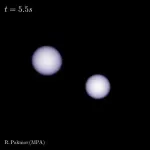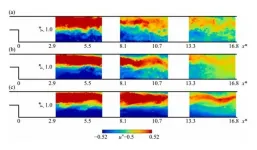(Press-News.org) University of Warwick astronomers have discovered an extremely rare, high mass, compact binary star system only ~150 light years away. These two stars are on a collision course to explode as a type 1a supernova, appearing 10 times brighter than the moon in the night sky.
Type 1a supernovae are a special class of cosmic explosion, famously used as ‘standard candles’ to measure distances between Earth and their host galaxies. They occur when a white dwarf (the dense remnant core of a star) accumulates too much mass, is unable to withstand its own gravity, and explodes.
It has long been theoretically predicted that two orbiting white dwarfs are the cause of most type 1a supernova explosions. When in a close orbit, the heavier white dwarf of the pair gradually accumulates material from its partner, which leads to that star (or both stars) exploding.
This discovery, published today in Nature Astronomy, has not only found such a system for the first time, but has found a compact white dwarf pair right on our doorstep in the Milky Way.
James Munday, PhD researcher at Warwick and leader of the investigation said, “For years a local and massive double white dwarf binary has been anticipated, so when I first spotted this system with a very high total mass on our Galactic doorstep, I was immediately excited.”
“With an international team of astronomers, four based at The University of Warwick, we immediately chased this system on some of the biggest optical telescopes in the world to determine exactly how compact it is.”
“Discovering that the two stars are separated by just 1/60th of the Earth-Sun distance, I quickly realised that we had discovered the first double white dwarf binary that will undoubtedly lead to a type 1a supernova on a timescale close to the age of the universe.”
“At last, we as a community can now account for a few per cent of the rate of type 1a supernovae across the Milky Way with certainty.”
Significantly, James’s new system is the heaviest of its type ever confirmed, with a combined mass of 1.56 times that of the Sun. At this high of a mass, this means that, no matter what, the stars are destined to explode.
The explosion is not due for another 23 billion years, however, and despite being so close to our solar system, this supernova will not endanger our planet.
Right now, the white dwarfs are leisurely spiralling around each other in an orbit taking longer than 14 hours. Over billions of years, gravitational wave radiation will cause the two stars to inspiral until, at the precipice of the supernova event, they will be moving so fast that they complete an orbit in a mere 30 – 40 seconds.
Dr. Ingrid Pelisoli, Assistant Professor at The University of Warwick and third author, added: “This is very significant discovery. Finding such a system on our galactic doorstep is an indication that they must be relatively common, otherwise we would have needed to look much further away, searching a larger volume of our galaxy, to encounter them.
“Finding this system is not the end of the story though, our survey searching for type 1a supernova progenitors is still ongoing and we expect more exciting discoveries in the future. Little by little we are getting closer to solving the mystery of the origin of type 1a explosions.”
For the supernova event, mass will transfer from one dwarf to the other, resulting in in a rare and complex supernova explosion through a quadruple detonation. The surface of the mass-gaining dwarf detonates where it is accumulating material first, causing its core to explode second. This ejects material in all directions, colliding with the other white dwarf, causing the process to repeat for a third and fourth detonation.
The explosions will completely destroy the entire system, with energy levels a thousand trillion trillion times that of the most powerful nuclear bomb.
Billions of years into the future, this supernova will appear as a very intense point of light in the night sky. It will make some of the brightest objects look faint in comparison, appearing up to ten-times brighter than the moon and 200,000 times brighter than Jupiter.
More details can be found in the full Nature Astronomy publication: DOI: 10.1038/s41550-025-02528-4
ENDS
Notes for Editors
University of Warwick press office contact:
Matt Higgs – Media & Communications Officer (Sciences)
Matt.Higgs@warwick.ac.uk | +44 (0) 7880175403
General and out of hours press office number +44 (0)7392 125605 (please call as emails are not checked out of office hours)
Research Funding:
James Munday was supported by funding from a Science and Technology Facilities Council (STFC) studentship. Ingrid Pelisoli acknowledges support from The Royal Society through a University Research Fellowship (URF/R1/231496)
Image Credit:
Artist’s impression available to download here. Images are free for use if used in direct connection with this story, but image copyright and credit must be ‘University of Warwick/Mark Garlick’
Caption: A digital illustration of the immense explosion of this double white dwarf binary star system, named WDJ181058.67+311940.94. In this picture, we capture the binary in the moment where the first white dwarf has just exploded, hurtling material towards its nearby companion which is on the cusp of explosion too. This event will occur in about 23 billion years, yet in only 4 seconds do both stars explode (Credit: University of Warwick/Mark Garlick)
Animation Credit:
Animation of the supernova event available to download here. Animation is free to use but full credit must be attributed to ‘Dr. Ruediger Pakmor, Scientific Staff, Max Planck Institute for Astrophysics’
About Warwick’s Astronomy and Astrophysics Group:
With over 100 staff and students, the Astronomy and Astrophysics group at Warwick is interested in a vast range of scales across the Universe: planetary systems, how they form, live and die; stars, stellar binaries and the exotic physical processes that they allow us to explore; as well as the transient events which mark the end of stellar lifetimes and the galaxies stars inhabit across the Universe. More details about The University of Warwick Astronomy & Astrophysics group can be found here: https://warwick.ac.uk/fac/sci/physics/research/astro/
END
Warwick astronomers discover doomed pair of spiralling stars on our cosmic doorstep
Warwick astronomers discover the first double white dwarf binary, destined to explode as type 1a supernova
2025-04-04
ELSE PRESS RELEASES FROM THIS DATE:
Soil conditions significantly increase rainfall in world’s megastorm hotspots
2025-04-04
Storm forecasting is traditionally based on studying atmospheric conditions but ground-breaking research that also looks at land surface conditions is set to transform early warning systems in tropical regions. This will enable communities to better adapt to the destructive impacts of climate change.
The new study led by the UK Centre for Ecology & Hydrology (UKCEH) has shown that a large contrast in soil moisture levels over a range of hundreds of kilometres results in atmospheric changes that increase rainfall area and amount in several megastorm hotspots globally. This increase ranges from 10 to 30% depending on the region and size ...
NK cells complexed with bispecific antibody yield high response rates in patients with lymphoma
2025-04-04
A novel cell therapy approach using cord blood-derived natural killer (NK) cells pre-complexed with AFM13, or acimtamig, a CD30/CD16A bispecific antibody, was safe and generated strong response rates for patients with refractory CD30-positive lymphomas, according to a new study from The University of Texas MD Anderson Cancer Center.
Results from the Phase I trial, published today in Nature Medicine, demonstrated an overall response rate of 92.9% and a complete response of 66.7% in 42 heavily pretreated patients. These findings ...
Planetary health diet and mediterranean diet associated with similar survival and sustainability benefits
2025-04-04
Milan, Italy – 4 April 2025. Two plant-based diets were associated with similar survival benefits and low environmental impact, according to research presented today at ESC Preventive Cardiology 2025,1 a scientific congress of the European Society of Cardiology (ESC).
Diet contributes significantly to cardiovascular disease mortality, with estimates indicating that across the European region, one in every five premature deaths could be prevented by an optimised diet.2
“In 2019, the Planetary Health Diet (PHD) was developed to optimise global dietary quality while keeping the environmental impacts of food production within sustainable planetary ...
Singapore launches national standard to validate antimicrobial disinfectant products
2025-04-04
SS 705 provides a first-of-its-kind Singapore-developed assessment to test the effectiveness of antibacterial, antifungal and antiviral potency, as well as durability of surface disinfectants and coatings.
Enables manufacturers to verify claims, regulators to set baselines and consumers to make safer, more informed choices.
Singapore, 4 April 2025—As public awareness of hygiene and infection control grows in a post-pandemic world, Singapore has launched a strategic national standard to strengthen public health and industry accountability in the rapidly expanding disinfectant market.
Jointly ...
Molecular stool test could improve detection of tuberculosis in adults with HIV
2025-04-04
The Xpert MTB/Ultra molecular diagnostic test for stool samples, until now recommended only for children, could be established as an additional test for diagnosing tuberculosis in adults living with HIV. This is the main conclusion of the Stool4TB Alliance study, led by the Barcelona Institute for Global Health (ISGlobal), an institution supported by the ”la Caixa” Foundation, in collaboration with the Manhiça Health Research Centre (CISM), the Research Center Borstel, the Makerere University, the Baylor College of Medicine Children’s Foundation – Eswatini, ...
Suspected fibrocartilaginous embolus in Asian small-clawed otter (Aonyx cinereus)
2025-04-04
An 11-year-old neutered male Asian small-clawed otter fell down the stairs while sleeping, after which it developed left-sided paralysis. Initial treatment involved once daily administration of prednisolone at 0.5 mg/kg.
Despite slight clinical sign improvements by day 10, paralysis persisted. MRI (T2WI) identified a well-defined, hyper-intense lesion on the left side within the spinal cord at the C2-3 intervertebral level. Based on CT and MRI findings, fibrocartilaginous embolus (FCE) was suspected.
Prednisolone was then tapered and by day 23 of illness, the otter was able to walk ...
Enhancing heat transfer using the turbulent flow of viscoelastic fluids
2025-04-04
Fluids play a crucial role in industrial processes like cooling, heating, and mixing. Traditionally, most industries would utilize Newtonian fluids—which have a constant viscosity—for such processes. However, many are now adopting viscoelastic fluids, which can behave as both liquids and elastic materials. These fluids can suppress turbulence in simple flows like straight pipes or channels, leading to reduced wall friction. This “drag reduction effect” has attracted significant interest due to its potential to enhance energy efficiency.
To advance the industrial applications ...
Exercise as an anti-ageing intervention to avoid detrimental impact of mental fatigue
2025-04-04
Retired people who habitually exercise are more able to fight the impacts of mental fatigue, new research suggests.
In a paper published in the Journal of Aging and Physical Activity, a team of researchers from the University of Birmingham and the University of Extremadura in Spain worked with groups of adults to find out whether age would increase, and regular exercise would decrease the impact of mental fatigue on a series of cognitive and physical performance tests.
In the first study, sedentary men between 65 and 79 performed worse in cognitive and physical tests compared to 52-64 year olds, with these ...
UMass Amherst Nursing Professor Emerita honored as ‘Living Legend’
2025-04-03
Many years ago, Cynthia Jacelon got an entry-level job in a challenging healthcare niche. It became the inspiration for a long, joyful and groundbreaking career in every dimension of nursing – for which she is now being honored.
“I am one of the few people who actually went to nursing school to work with older adults,” explains Jacelon, professor emerita at the Elaine Marieb College of Nursing and senior advisor at the Elaine Marieb Center for Nursing ...
New guidelines aim to improve cystic fibrosis screening
2025-04-03
All states should adopt updated screening protocols so more newborns with cystic fibrosis can be diagnosed in the first weeks of life, when interventions can have the greatest benefit, according to the Cystic Fibrosis Foundation guidelines published April 2 in the International Journal of Neonatal Screening.
Current newborn screening protocols vary across states. Some states use outdated protocols that often miss cases of the inherited disease, especially in newborns with Black, Hispanic and Asian, as well as American Indian and multiracial ancestry, said ...
LAST 30 PRESS RELEASES:
Scalable and healable gradient textiles for multi‑scenario radiative cooling via bicomponent blow spinning
Research shows informed traders never let a good climate crisis go to waste
Intelligent XGBoost framework enhances asphalt pavement skid resistance assessment
Dual-function biomaterials for postoperative osteosarcoma: Tumor suppression and bone regeneration
New framework reveals where transport emissions concentrate in Singapore
NTP-enhanced lattice oxygen activation in Ce-Co catalysts for low-temperature soot combustion
Synergistic interface engineering in Cu-Zn-Ce catalysts for efficient CO2 hydrogenation to methanol
COVID-19 leaves a lasting mark on the human brain
Scientists use ultrasound to soften and treat cancer tumors without damaging healthy tissue
Community swimming program for Black youth boosts skills, sense of belonging, study finds
Specific depressive symptoms in midlife linked to increased dementia risk
An ‘illuminating’ design sheds light on cholesterol
Who is more likely to get long COVID?
Study showcases resilience and rapid growth of “living rocks”
Naval Research Lab diver earns Office of Naval Research 2025 Sailor of the Year
New Mayo-led study establishes practical definition for rapidly progressive dementia
Fossil fuel industry’s “climate false solutions” reinforce its power and aggravate environmental injustice
Researchers reveal bias in a widely used measure of algorithm performance
Alcohol causes cancer. A study from IOCB Prague confirms damage to DNA and shows how cells defend against it
Hidden viruses in wastewater treatment may shape public health risks, study finds
Unlock the power of nature: how biomass can transform climate mitigation
Biochar reshapes hidden soil microbes that capture carbon dioxide in farmland
Reducing saturated fat intake shows mortality benefit, but only in high-risk individuals
Manta rays create mobile ecosystems, study finds
Study: Mixed results in using lipoic acid to treat progressive multiple sclerosis
Norbert Holtkamp appointed director of Fermi National Accelerator Laboratory
New agentic AI platform accelerates advanced optics design
Biologists discover neurons use physical signals — not electricity — to stabilize communication
Researchers discover that a hormone can access the brain by hitchhiking
University of Oklahoma researcher awarded funding to pursue AI-powered material design
[Press-News.org] Warwick astronomers discover doomed pair of spiralling stars on our cosmic doorstepWarwick astronomers discover the first double white dwarf binary, destined to explode as type 1a supernova





